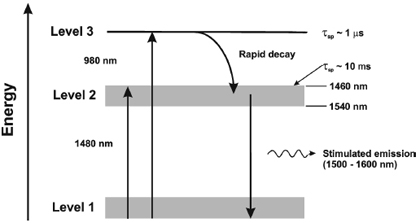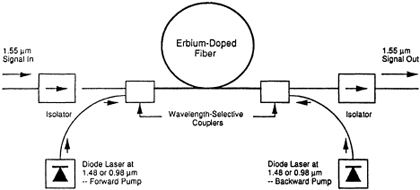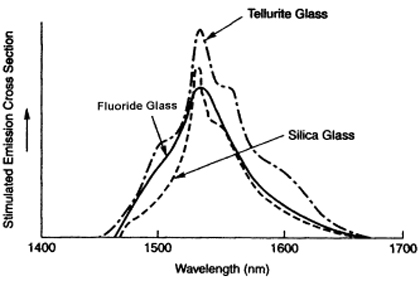Optipedia • SPIE Press books opened for your reference.
Brief review of optical fiber amplifiers
Excerpt from Infrared Fibers and Their Applications
Fiber optic amplifiers operate on the same principle as a laser except that there is no external optical cavity as there is for a laser. The active lasing medium is a host ion, which in the case of the OFAs is a RE ion like Er3+ added to the host glass or crystal structure. Specifically, erbium ions in concentrations of about 1000 ppm-weight % are added to the core of an SM fiber to make an EDFA. A source of pump energy is provided by a diode laser. An energy-level diagram for Er3+ in silica is shown in Fig. 10.1. The pump laser light from either a 980- or 1480- nm source laser excites the Er ions to an excited state where they make a rapid, nonradiative decay to a long-lived metastable state, 4I13/2. From there they undergo spontaneous or stimulated emission to the lower-energy 4I15/2 state. The incoming signal, with wavelengths spanning the range from 1500 to greater than 1600 nm, will be amplified by stimulated emission. An example of how an EDFA can be used as an in-line amplifier is shown simply in Fig. 10.2. In this case, the incoming signal light at, say, 1550 nm is pumped with either a forward or backward diode laser. Isolators located before and after the EDFA prevent the pump signal from being transmitted along with the amplified signal.

Figure 10.1 Three-level energy diagram for Er3+ in silica showing pump bands at 1480 nm and 980 nm and emission from metastable level 2 to ground state level 1.
A key to the operation of a broadband OFA is a wide emission band covering the important telecommunication bands. The stimulated emission cross section for Er3+ ions doped into several different glass hosts is shown in Fig. 10.3.1 This data indicates the wavelength region for lasing or amplification by stimulated emission. From Fig. 10.3 it can be seen that the host fluoride glass and silica fibers have about the same cross section over approximately the same wavelength range. The emission band is broader for the telluride glass, and this is an advantage for increasing the number of channels in DWDM applications.

Figure 10.2 General telecommunications application of an EDFA configured for either forward or backward pumping. [Reproduced from J. Buck, "Optical Fiber Amplifiers,"Handbook of Optics, Vol. IV, 2001, with permission from The McGraw-Hill Companies.]
The most efficient lasing action occurs when depopulation of the metastable state leads to radiative transitions. However, there are competing transitions that can also depopulate the metastable state and, therefore, reduce the number of stimulated photons emitted. These nonradiative transitions can dissipate energy as heat or phonons. Energy can also be lost from the metastable state as a result of excited state absorption (ESA) in which the pump light excites Er3+ ions from the metastable state to higher-energy states. Phonons with the highest frequencies are most likely to participate in the nonradiative process. This is because the dissipation of the ion's energy into only a few phonons with high energy is a loworder process and, therefore, more probable than higher-order processes involving a greater number of low-frequency phonons. Therefore, host glasses with a lowphonon- frequency spectrum, i.e., the IR glasses, will have relatively lower nonradiative relaxation rates compared to the oxide glasses. For example, the maximum phonon energy in silica glass is 1000 cm-1 versus 460 cm-1 for ZBLA glass. The nonradiative transition rate is greatly reduced for the ZBLA glass as a result of this difference in maximum phonon frequencies.

Figure 10.3 Simulated emission cross section for Er3+-doped fibers for various glass hosts.1 [Reprinted by permission of Pearson Education, Inc., Upper Saddle River, NJ.]
Another advantage of using IR fiber hosts for RE doping is that it is possible to obtain lasing or amplification at wavelengths longer than 1.55 µm, as well as at 1.3 µm where the EDFAs do not operate. For example, doping with Tm3+, Er3+, and Ho3+ ions in fluoride glass fibers results in laser operation at 2.3, 2.71, and 2.9 µm, respectively. While these are not important telecommunication wavelength bands, they are nevertheless potentially important for power delivery in microsurgical applications as well as convenient sources in the 2- to 3-µm region. When IR fibers are doped with
Pr3+, the fibers can be used to provide amplification at the important 1300-nm telecom band.
References
J. Harrington, Infrared Fibers and Their Applications, SPIE Press, Bellingham, WA (2003).
View SPIE terms of use.

